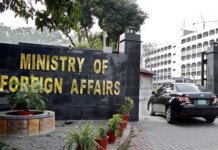Islamabad, 9 February 2023 (TDI): With its foreign exchange reserves almost depleted due to a worsening economic crisis, Pakistan is in desperate talks with the International Monetary Fund (IMF).
It is straining to pay off extremely high levels of foreign debt and only has enough money to cover less than a month’s worth of routine imports.
After ten days of negotiations with the government aimed at releasing crucial foreign funding, an IMF delegation is scheduled to depart the nation on Thursday.
In Pakistan, annual inflation reached above 27% in January, the highest level since 1975, and there are growing concerns for the economy in this crucial election year.
This week, the rupee hit an all-time low against the dollar, falling from 175 to 275, making purchases and payments more expensive in Pakistan. One of Pakistan’s most urgent issues is its dearth of foreign currency.
Recent factory closures in Pakistan’s industrial heartland of Faisalabad, including Jubilee Textiles, were not caused by the country’s frequent power outages, which have plagued it for years, but rather by a lack of access to dollars to pay for the supplies they require.
“How can we manufacture if we can’t import? We’ve already lost money,” Fahim, its manager, told the media that all 300 of the company’s employees had been sent home.
Fahim said that the plant had run out of the dyes they purchase from China as he made his way through the network of frozen machines.
This was not because the dyes were unavailable; rather, they claim that their bank would not have cleared the funds to pay for the dyes for weeks.
Analysts claim that the government was secretly maintaining the bank’s exchange rate artificially high, which was a factor in the system’s dearth of dollars. They permitted it to decline at the conclusion of the previous month.
Industries and firms all throughout Pakistan reported having to slow down or stop operations while they also awaited the arrival of imported commodities that are currently piled up in ports.
Over 8,000 containers, including everything from food to medication, were piled up in Karachi’s two ports, a government Minister told the media in late January. It has reportedly started to clear, but a lot of it is still trapped, according to local media sources.
Like many other nations, Pakistan is also suffering from the coronavirus pandemic and Russia’s invasion of Ukraine, which led to a sharp increase in the price of petroleum worldwide.
Pakistan is increasingly dependent on imported fossil energy, and the cost of importing food has increased. Fuel prices increase when the rupee weakens, which has an impact on the price of manufactured or transported goods.
The government just raised fuel costs by almost 13%, although it claims there will be no more increases. Add to it the price of last year’s floods, which the UN estimates cost more than $16 billion in damage.
Large portions of Pakistan were flooded, ruining farms and impairing the country’s ability to generate food. The cost of staples like wheat and onions has risen.
All of this occurs in a volatile and uncertain political environment because an election is scheduled for the end of the year. Regarding bailouts, Pakistan is not unfamiliar with them.
The nation has struggled for a long time to wean itself off populist subsidies and stabilize its economy despite having a sizable military budget and years of debt-driven infrastructure expenditure.
According to Dr. Sajid Amin Javed, who is working as deputy executive director at the Sustainable Development Policy Institute in Islamabad, “If you look at the history of Pakistan, we have a cycle of the balance of payments concerns.”
We go to the IMF, put in place really stringent reforms for two to three years, and then, regrettably, we undo them all because it’s an election year. He believes that in Pakistan, subsidies have traditionally been utilized to win votes.








